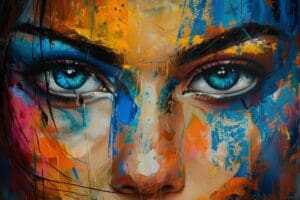Art has always been a reflection of the emotions, personal struggle, and the path breaking events of a contemporary society. When a society demands or undergoes a change, art has mostly subtly complied with it. The Oxford Dictionary describes art as “the quality, production, expression, or realm, according to aesthetic principles, of what is beautiful, appealing, or of more than ordinary significance.” In effect, art definitely is an expressive platform for individuals, groups, as well as society, especially the radical changes or events witnessed thereof. It usually depicts the current or a particular scenario in the purview of the political situation, economic, social, geographical, the emotions spun therein, the undertones of revolutions, and uprising, to name just some.
If we go periodical about discussing art as a reflection of society, then we begin from the most ancient. The ‘Prehistoric Art’ consisted of paintings on the rocks and caves, which symbolized their routine lifestyles and rituals. The paintings were therefore, an evidence of their culture, which helped historians derive information about the life, culture, and the civilization of this era. The famous ‘Indus Valley’ or ‘Harappa,’ ‘Greek,’ and ‘Egyptian’ civilizations, especially had prolific artistry, including sculpture, architecture, paintings, engravings, and metal art.
In fact, the most we know about these amazingly rich civilizations, is credited to their narrative artifacts and buildings only. For instance, the ‘Egyptian Civilization’ believed in life after death. The society therefore, had a strong spiritual framework, concentrating more on the human journey after death. They believed in immortality and worshipped many deities, a fact distilled from the paintings adorning the walls of the great Pyramids. The Greek Civilization however, was more emphatic about the human form, its poise, and beauty, reflecting mostly on the attires, body languages, hairstyles, and cultures prevailing over different periods.
Creativity adopted the sects of ‘Art Movement’ to depict the realities of a contemporary society, vis-à-vis, its stable fabric, regularly changing aspects, and even revolutions. The impact of the contemporary socio-political scenario has also always been portrayed. For instance, before the First World War, Paris used to bustle with great political activity. This restlessness somewhere influenced the development of ‘Cubism’ by Pablo Picasso and Georges Braque. ‘Cubism’ involved the depiction of a particular subject from multiple angles, a practically prevalent situation then. The artistry turned mysterious in essence, to manifest the hatching of diverse political conspiracies in Paris at that time.
Expressionism’ was another art form developed, when the society was undergoing transitions at different levels, including creative. There was a revolt against the traditional outlook towards art. A modern approach was adopted. The ‘Modern Art’ was a blend of ‘Abstract Realism,’ in which the subject was distorted to depict its reality and emotional upheaval. The colors in the paintings have nearly always portrayed the true emotions of the subject, the event, or the mood of the artists.
To conclude, we can say that art may always not be beautiful aesthetically or comprehensible to all. It however, should be powerful enough to portray the current emotions of the society, including exposing harsh and subtle truths, while also encouraging the betterments. The only constant in the world is change. In tune, societies metamorphose through different annals of time and art helps capture the resulting twists and turns in the contemporary culture and lifestyle.





